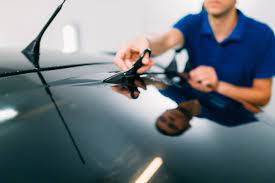In the modern world, where aesthetics meet https://www.brooklynwindowtinting.com
functionality, window tinting stands out as both a practical and stylish choice. Whether you’re considering it for your home, office, or vehicle, window tinting offers a blend of benefits that go beyond mere visual appeal. This article delves into the art and science behind window tinting, exploring its various applications, advantages, and the technology that makes it possible.
The Basics of Window Tinting
At its core, window tinting involves applying a thin film to the glass surface. This film is typically made of polyester and is infused with materials that can absorb or reflect sunlight. Window tinting films come in various shades, from nearly clear to dark, and can be customized to fit specific needs and preferences.
Types of Window Tinting Films
- Dyed Films: These films are the most basic type and work by adding a layer of dye to the glass. While they provide privacy and reduce glare, they don’t offer as much heat rejection as other types.
- Metalized Films: These films contain metal particles that reflect sunlight away from the glass. They are effective at reducing heat and UV rays but may interfere with electronic signals, such as those from GPS and cell phones.
- Carbon Films: Carbon films are a more advanced option that combines carbon particles with the film. They offer excellent heat rejection, UV protection, and do not interfere with electronic signals. They also tend to maintain their appearance better over time.
- Ceramic Films: These are the most advanced type of window tinting. They use nano-ceramic technology to provide superior heat rejection, UV protection, and clarity. They also don’t interfere with electronic signals and have a longer lifespan.
Benefits of Window Tinting
- Heat Reduction: One of the primary advantages of window tinting is its ability to reduce heat. By blocking a significant portion of solar energy, tinted windows can keep interiors cooler, reducing the need for air conditioning and saving on energy costs.
- UV Protection: Window tinting films block a high percentage of UV rays, which can help protect your skin and reduce the risk of skin cancer. Additionally, they prevent fading and deterioration of furniture and other interior materials.
- Enhanced Privacy: Tinted windows provide added privacy by making it harder for outsiders to see inside. This can be particularly valuable in both residential and commercial settings.
- Glare Reduction: The reduction in glare makes driving safer by minimizing the blinding effects of the sun, especially during sunrise and sunset. This benefit extends to work environments and homes as well.
- Aesthetic Appeal: Beyond functionality, window tinting enhances the visual appeal of vehicles and buildings. It can give a sleek, modern look that complements the overall design.
The Installation Process
Installing window tinting requires careful preparation and expertise. The process typically involves the following steps:
- Cleaning the Glass: Thorough cleaning is crucial to ensure that the tint adheres properly and there are no impurities between the film and the glass.
- Measuring and Cutting: The film is measured and cut to fit the specific dimensions of the window.
- Application: The film is applied to the glass using a solution that allows for repositioning and smoothing out any bubbles or wrinkles.
- Curing: Once applied, the film needs time to cure. This can take several days, during which the window should not be rolled down or cleaned.
Maintenance and Care
Maintaining tinted windows is relatively simple. Regular cleaning with non-abrasive, ammonia-free cleaners will help preserve the film’s appearance and functionality. Avoid using sharp objects that could scratch the film and be cautious when using high-pressure water sources.
Legal Considerations
It’s important to be aware of local regulations regarding window tinting. Laws vary by region and can dictate the level of tint allowed for different types of vehicles and buildings. Always check the local laws to ensure compliance and avoid potential fines.
Conclusion
Window tinting is more than just a cosmetic enhancement; it’s a smart investment that offers numerous benefits ranging from energy efficiency to enhanced privacy and aesthetic appeal. With advancements in film technology, there’s a solution to meet nearly every need and preference. Whether you’re looking to upgrade your vehicle, home, or office, window tinting provides a blend of art and science that can make a significant difference in comfort, safety, and style.




